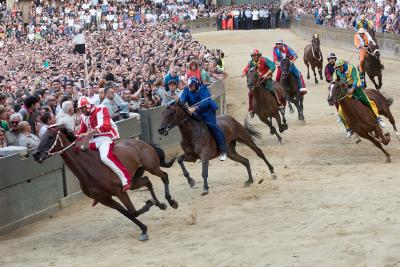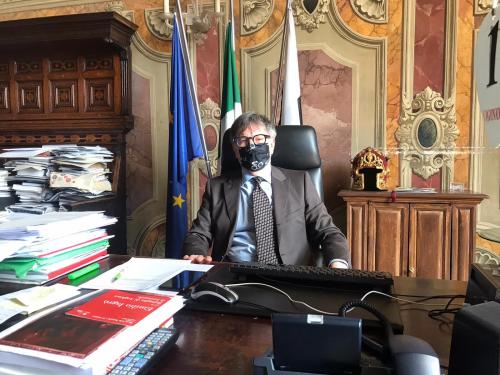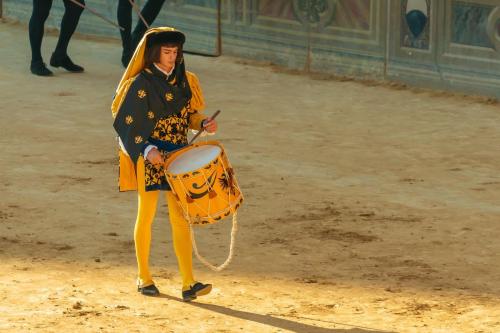Ride or die: without historic Palio, Siena is at a loss

SIENA - When the Palio di Siena didn’t take place on its usual day for the first time since the Second World War, its reigning champion, Giovanni Atzeni, holed up in his backyard stable outside his Tuscan villa, 35 expensive racehorses for company.
“On the day the Palio would have happened, I stayed with my horses,” said Atzeni, 36, the seven-time victor of the notoriously brutal, 500-year-old bareback horse race that was put on ice last year in the wake of Covid. “But my heart pounded as if the race was still on.”
With the Palio likely to be cancelled this year, too, Atzeni now spends most of his days as a freelance jockey, taking part in spectatorless races on the Italian hippodrome circuit, paid for by the government and broadcast by Sky Sports.
But the annual competition, usually held on July 2 and August 16, represents far more than the pyronautics of its death-defying jockeys. It is, rather, the culmination of a year’s worth of impassioned preparation on the part of Siena’s 250,000 residents, and its absence for almost two years has been felt citywide.
“Our culture of Palio, it is not only a horse race,” said Siena’s leghista mayor Luigi de Mossi, 66, from his office in the Palazzo Pubblico, the 13th century gothic palace that dominates the Piazza del Campo, Siena’s large, sloping central square. “What the tourists don’t see is the part of the Palio that is kind of an underworld, a relationship in the winter time and spring time between all the contradas. Without it we have lost a part of our identity.”
Certainly, though, the race itself is spectacular, unfolding as a sub-one-minute frisson of adrenaline among ten horses racing haunch-to-haunch around the impossibly tight bends of Siena’s heavily crowded Piazza del Campo, during which they are prone to abruptly fall, crush their riders, or else violently die in some other way.
Riders represent Siena’s 17 historic districts, or contradas, ten of which take part each year. Named for various flora and fauna, such as Aquila (Eagle), Lupa (She-Wolf), Giraffa (Giraffe) and Chiocciola (Snail), they spend the months before each race obsessively preparing. Horses are blessed by a priest before the main event, and victory comes to the first to complete three laps of the heavily crowded Piazza del Campo with its head ornaments intact, with or without its rider, or fantino. Fantini are permitted to whip and shove their opponents off their mounts mid-race, and the only rule is that they cannot grab another rider’s reins.
During the race, humiliating a rival often takes priority over winning outright, and contradas are known to forge byzantine pre-Palio alliances with the intent of undermining common enemies. In backroom meetings, they trade horses, riders and strategies readily. Atzeni, for instance, who was actually born in Germany and has won victories for four different contradas, says he will race for whichever offers the “best horse.”
You’ll find it all at the Palio. Ritualistic violence, often spilling over into regular violence, serves as a release valve for simmering tensions. Effigies representing X year’s loser get strung up on makeshift gallows in the street. Atzeni’s mentor, the former champion Luigi Bruschelli, was jailed after getting caught microchipping horses to make them look like a different breed. An illegal betting operation worth upwards of 15,000 euros and run via a computer server in Wolverhampton was busted by local authorities in 2015.
Yet beyond its role as a sporting event, the Palio serves as an engine of social cohesion, said De Mossi from his large desk in the Palazzo, under a vaulted ceiling adorned with a renaissance work whose name he said he didn’t know. He said that unlike a football game, or a cricket match, the Palio’s preparation involves all the city’s inhabitants at all levels of society, including municipal workers, merchants, and schoolkids.
The involvement runs deep, he said. Neighbourhoods raise flags along their streets representing the insignia of their contradas. Before and after the main event, which usually takes place in mid July and again in mid August, wild district-wide parties and concerts are thrown, large banquets are held, and processions featuring 15th century traditional costumes and drum-beating schoolkids explode noisily throughout the city.
The tourist sector is also heavily involved, accommodating the conspicuously wealthy cohort that appears each year and includes many Brits, among them Helen Mirren, Jeremy Clarkson and Tony Blair, who used to stay during his visits in a nearby castle owned by a Tuscan prince.
All of these elements have held together Siena’s social fabric for decades if not centuries, meaning the Palio’s absence has been felt acutely. Restaurateurs now have no foreign dignitaries to serve, Irish Pubs no catatonic Brits. It’s a bad time for Wolverhampton bookies, and the drummers who make up the core of the processions that normally march through the city in medieval garb, such as Eugenio “Gegio” Vedovini, 20, have little to do.
“The period without the Palio, for a drummer, is very difficult,” said Vedovini. “In my case—and in the case of all drummers, spending days doing basically nothing has been hard.”
Indeed, Vedovini hasn’t taken part in official practice since June 2020, although limited sessions are expected to resume in the months ahead. He worries about his drumming skills fading: The tamburini are a competitive bunch, and becoming good enough to take part in the flagship procession before the Palio, as Vedovini has done, is a source of great pride and prestige. He began at the age of two, and described the experience of marching into the piazza as almost “libidinal.”
“There’s no emotion more beautiful, indescribable,” he said. “If there’s no Palio this year it’ll be a great blow, the Palio is life, we live for it, if you told me last year that the Palio wouldn't run in 2021, too, I would have been disappointed beyond belief. We live it in our blood—but we need to see how the vaccines go.”
Carlo Piperno, 60, a representative of the low-slung Lupa contrada, said there had also been a damaging effect on law and order. While Siena is generally known as a crime-free city, he said, with restrictions on freedom of movement “mini-gangs” from out of town began harassing passersby in the Piazza del Campo last year. He said it was only after lockdown eased and large-scale gatherings of tambourine-players returned that the gangs disappeared. “Just being there, with this presence, the contrada made sure that the boys from the mini gang weren’t there.”
All of this made last year’s decision to cancel the Palio uniquely difficult, said Piperno, who was present at meetings between the contradas and the mayor’s office relating to the matter. “There was a sense of great bitterness and disappointment,” he said. “But ultimately it was unanimous.”
And the prospect of doing it de minimis, with the race but without the crowds, was inconceivable. Roughly 1,700 spectators typically crush together in the Piazza del Campo, supplying an electric atmosphere.
“It’s simply not possible to do a small Palio,” said Piperno. “The race itself can be done, but you lose the sense of the Palio. The preparation involves everyone, and you live it in the days and months before and after. It’s impossible to do it differently—if you do, it’s not the Palio.”
“A football match can be played without the public,” said Giampiero Cito, 44, of the Aquila contrada, who was also present at the meeting. “But with the Palio that doesn’t make sense—its magic comes from the people, the spectators, the atmosphere.”
There were, at least, ways in which Siena’s unique urban makeup was beneficial during the pandemic. Sienese say that from the very beginning the contradas came into their own, providing aid to vulnerable people, carrying out grocery shops and home care, as well as supplying hospitals with necessary equipment and bulk-buying masks to deliver to the general population.
“Neighbouring cities like Florence and Grosseto had to pay thousands of euros for masks and medical equipment,” said de Mossi, the mayor. “I didn’t have to spend a penny.”
Mayor de Mossi and the contradas are waiting until May before ratifying a final decision on whether this year’s Palio will proceed as normal, but given Italy’s achingly slow vaccine rollout the likelihood of that happening is low.
There are also questions hovering over the future of the Palio, which animal rights activists, or animalisti, condemn for the longstanding practice of summarily putting down horses who are injured mid race. The group Animalisti Italiani has urged Siena to use the pandemic as an opportunity to put an end to the competition for good.
“People who think they defend the animals in general probably they don’t know the tradition,” de Mossi scoffed, claiming that the city provides horses with a veterinary clinic, as well as a “horse resort” where retired horses finish their days until they pass.
As to whether the likely second suspension of the Palio could threaten its future, Sienese baulk, describing its pull as being of an almost cosmic nature. Cito, of Aquila, doubles as a creative director at a PR firm, but when the Palio takes place he says he becomes “primitive.”
"It’s something that belongs to the bottom of our consciousness,” he said. “It is not rational. When there’s a victory it’s like an orgasm, it’s impossible to control. I’ve seen old men crying, adults fighting with each other.” He said his earliest recollection of the Palio was as a toddler, seeing his mother yell as the race began.
Indeed, the race is so thoroughly woven into the fabric of Sienese civic life that in some quarters preparation for it, even with the pandemic still raging, goes on unimpeded.
There is Vedovini, the drummer, who several times a week heads out to a secluded garden behind his contrada’s headquarters to practice banging his big drums. In late April, meanwhile, the jockey Atzeni travelled to the small Tuscan fortress town of Monteriggioni with four horses—Zio Rosas, Aurus, Tristezza, and Viso D’Angelo—to have them assessed for the Palio as if it would be taking place, parading them before veterinarians, the mayor, and a smattering of journalists—though far fewer than usual.
“Siena is preparing to do the Palio, as always,” said Atenzi, explaining that merely going through the motions helps maintain civic pride in the city. “This is very important.”
There is no chance of it ending for good, agreed Piperno, of Lupa. “It’s like if you have a brother and you don’t see for a year, you’ll still see him—he’s your brother.”
“There is a Sienese saying that those who are born here are ‘elastic,’” he added. “The city is almost a physical force, and it always pulls us back.”
jp-ol-bm
no unauthorised reproduction permitted, copyright Italian Insider ©




